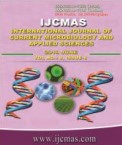


 National Academy of Agricultural Sciences (NAAS)
National Academy of Agricultural Sciences (NAAS)

|
PRINT ISSN : 2319-7692
Online ISSN : 2319-7706 Issues : 12 per year Publisher : Excellent Publishers Email : editorijcmas@gmail.com / submit@ijcmas.com Editor-in-chief: Dr.M.Prakash Index Copernicus ICV 2018: 95.39 NAAS RATING 2020: 5.38 |
Feeding is the most important factor in silkworm rearing, as it has a direct impact on growth and development of worms. Silkworm requires feed five times a day at an interval of five hours. However, the rearers of J&K state feed the worms two times only, resulting in lower cocoon yield. Feeding of quality mulberry leaves has a great impact on biology and physiology of silkworm Bombyx mori L. The study revealed 3 feedings per day was statistically at par with 4 feedings in terms of various parameters including larval survival percentage i.e. 93.50 ± 0.76 for 3 feedings and 95.00 ± 0.57 for 4 feedings, larval weight 40.00 ± 2.00 a for 3 feedings and 40.66 ± 1.45 for 4 feedings, cocoon yield 14.10 ± 0.38 by wt. and 9183.30 ± 44.09 by no. for 3 feedings and 14.82±0.38 by wt. and 9366.70 ± 60.09, single cocoon wt. 1.54 ± 0.02 g for 3 feeds and 1.61 ± 0.00 for 4 feeds, single shell weight was recorded as 0.32± 0.00 and 0.33± 0.00 for 3 and 4 feeds respectively. Shell ratio percentage was recorded as 20.66 ± 0.26 and 20.95 ± 0.11 respectively for 3and 4 feeds. However, total filament lengths 721.0 m and 765.3 m, non-breakable filament lengths 680.6 m and 765.3 m and filament size 3.0 d and 2.73 d for 3 and 4 feeds respectively. From this experiment it can safely be concluded that three feedings are obligatory for obtaining successful cocoon crop at field level.
 |
 |
 |
 |
 |